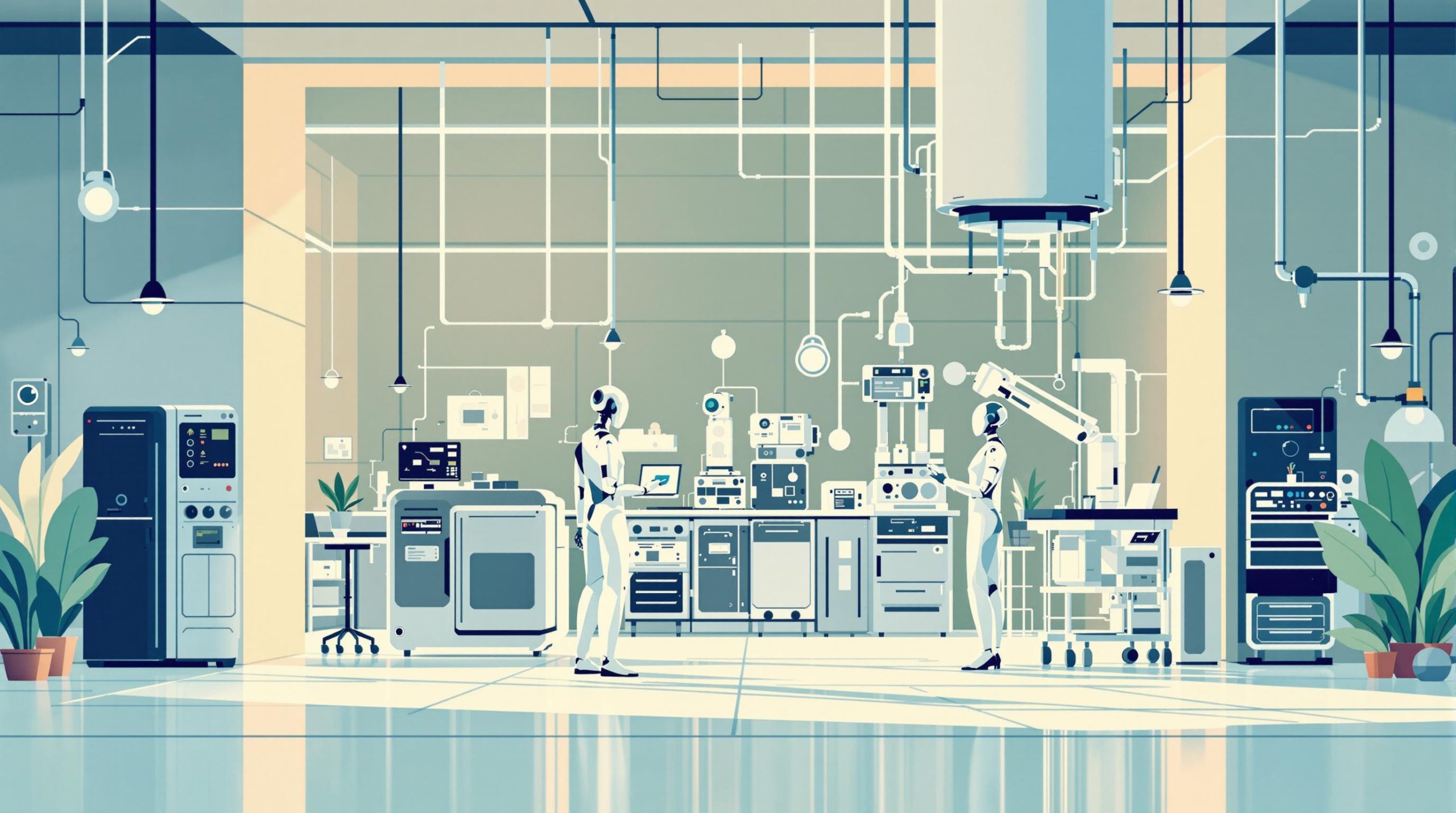AI agents are transforming industries by going beyond traditional software. They’re improving efficiency, decision-making, and innovation in areas like healthcare and manufacturing. Here’s how:
- Healthcare: AI reduces diagnostic errors, automates administrative tasks, and saves up to $360 billion through shorter hospital stays and smarter resource use. Adoption rates vary, with 18.7% of US hospitals using AI, led by New Jersey at 48.94%.
- Manufacturing: AI minimizes downtime, cuts waste, and boosts productivity. Companies like General Motors save 30% on material waste, while Siemens increases production efficiency by 15%.
Quick Comparison
| Aspect | Healthcare | Manufacturing |
|---|---|---|
| Key Benefits | Faster claims, better diagnostics | Predictive maintenance, automation |
| Efficiency Gains | 30% faster claims review | 33% drop in labor costs |
| Challenges | Data privacy, high costs | Outdated systems, data quality |
| Economic Impact | $200–$360 billion savings | Reduced operating expenses |
AI is reshaping these sectors by improving outcomes and cutting costs, despite challenges like data security and integration. This shift signals a broader transformation across industries.
Vertical AI Agents Could Be 10X Bigger Than SaaS
1. AI in Healthcare
AI is making waves in healthcare, with 18.70% of US hospitals now using AI systems to reshape medical operations [1].
Adoption Rates and Implementation
AI adoption in healthcare is on the rise. Among hospitals, 3.82% are considered high adopters, 6.22% moderate, and 8.67% low adopters [1]. New Jersey leads the way, with 48.94% of its hospitals integrating AI, followed by Utah at 41.38% and Connecticut at 35% [1].
Efficiency Gains
AI tools are transforming how hospitals operate. By streamlining workflows, automating routine tasks, and improving predictions for staffing and demand, these systems help reduce the administrative workload – currently taking up to 70% of a practitioner’s time [4]. This lets healthcare professionals spend more time with patients, improving care quality and service delivery.
Economic Impact
AI adoption could lead to massive savings, estimated between $200–$360 billion, through shorter hospital stays, fewer nursing discharges, and smarter resource use [2][3]. For instance, hospital stays could drop by 25%, and nursing facility discharges by 91% [3].
Challenges
Despite its benefits, implementing AI in healthcare isn’t without obstacles. Hospitals must navigate regulatory compliance, address data ethics concerns, integrate new systems, and train staff to use them effectively [3][4]. Even with these challenges, the improvements in efficiency, cost management, and patient care highlight AI’s growing role in reshaping healthcare.
AI’s impact on healthcare is undeniable. While it’s saving lives and cutting costs in this sector, its influence is equally transformative in fields like manufacturing, where it’s streamlining production and supply chains.
sbb-itb-5392f3d
2. AI in Manufacturing
Adoption Rates
AI adoption in manufacturing varies by company size. Larger manufacturers (with over 250 employees) are ahead, with an adoption rate of 7.2%. Smaller firms are catching up at 5.5%, thanks to more affordable AI solutions becoming available [6].
Efficiency and Economic Impact
AI is making waves in manufacturing by boosting efficiency and cutting costs. For example, General Motors uses AI-driven planning to reduce material waste by 30% across its plants [8]. Siemens has also seen a 15% increase in production efficiency through AI-powered systems [8].
Here’s what AI is helping manufacturers achieve:
- Minimized equipment downtime with predictive maintenance
- Optimized production processes for better output
- Efficient use of resources to cut waste
- Improved quality control for consistent results
Challenges
"Data security and accuracy are critical concerns in manufacturing due to high-stakes processes and proprietary data", says Thomas George, President of Cybermedia Research [5].
Despite its benefits, AI adoption comes with challenges. These include:
- Data Quality: Manufacturers need large volumes of accurate data to train AI models effectively [7].
- Outdated Infrastructure: Many companies struggle to integrate AI with older machinery and software [5].
- Lack of Expertise: Managing and maintaining AI systems often requires specialized skills that may not be available in-house [5].
To address these issues, many manufacturers turn to commercial AI solutions. These systems offer easier integration, dependable support, and performance guarantees, especially in high-stakes industrial settings. As George explains:
"Commercial LLMs offer more straightforward integration mechanisms, ongoing support, and robust performance guarantees in industrial cases where consequences are severe" [5].
While AI brings clear benefits to manufacturing, such as improved efficiency and reduced costs, the challenges it poses are significant. These hurdles reflect broader trends in AI adoption across various industries.
Comparing the Benefits and Drawbacks
AI agents are making waves across industries, with healthcare and manufacturing showcasing distinct ways of using this technology. In healthcare, AI helps improve diagnostic accuracy and streamline patient care. Meanwhile, manufacturing focuses on boosting efficiency and cutting costs.
This comparison highlights how AI is changing the game in both fields, redefining what success looks like. For instance, companies like General Motors save money with AI-driven planning, while healthcare providers use AI to speed up processes and improve diagnostics [9][10].
| Aspect | Healthcare | Manufacturing |
|---|---|---|
| Primary Benefits | Better diagnostics, personalized care, and improved admin processes | Automation, predictive maintenance, and streamlined logistics |
| Efficiency Gains | 30% faster claims review times [10] | 33% drop in labor costs [11] |
| Key Challenges | Data privacy concerns, high implementation costs, and system integration issues | Workforce adjustments, outdated infrastructure, and data quality problems |
| Economic Impact | Better patient outcomes, lower admin costs | Reduced operating expenses, higher productivity |
AI’s integration with IoT and blockchain is pushing innovation in both sectors. However, each industry faces unique hurdles. Manufacturers grapple with integrating new systems and managing data effectively, while healthcare providers focus on data security and meeting compliance standards [12].
The economic effects differ as well. Manufacturers see major savings from automation and predictive maintenance, while healthcare providers cut costs through efficient care coordination [9]. Although the upfront costs can be steep, both industries show that AI offers long-term value [12].
These differences underline how AI adapts to various needs, showcasing its ability to drive change across multiple fields.
Conclusion
AI is reshaping industries like healthcare and manufacturing, moving beyond basic automation to take on complex decision-making tasks that improve workflows and boost efficiency.
In healthcare, AI is changing the game by reducing diagnostic errors and simplifying administrative tasks. For example, organizations have reported 30% faster review times for claims processing [10]. These time savings lead to better patient care and lower operating costs.
In manufacturing, AI is driving major gains in productivity and cost savings. Companies using AI-powered systems have seen a 33% drop in labor costs [11], while also improving product quality and using predictive analytics to fine-tune inventory management [9]. These advancements highlight how AI is setting new benchmarks for efficiency and product excellence.
When comparing these sectors, it’s clear that AI’s impact differs based on specific needs. Healthcare focuses on improving patient care and cutting down administrative burdens, while manufacturing zeroes in on boosting production and managing costs. This flexibility shows how AI can tackle unique challenges across industries.
With continued progress in machine learning and access to data, AI adoption in these fields is set to grow even faster. This isn’t just about technology – it’s about rethinking how industries operate. As AI systems evolve, they’ll keep driving change, sparking new ideas, and improving efficiency in ways we’ve only started to explore.

